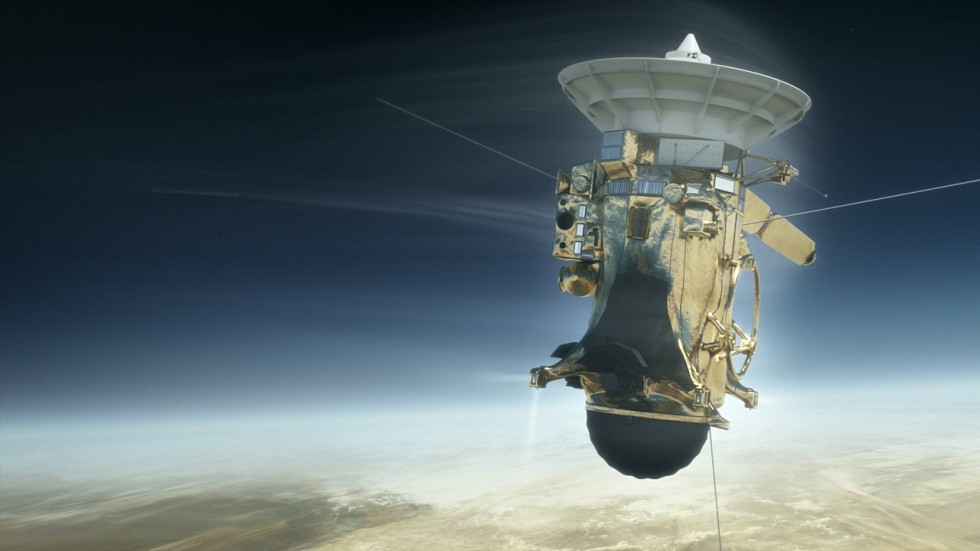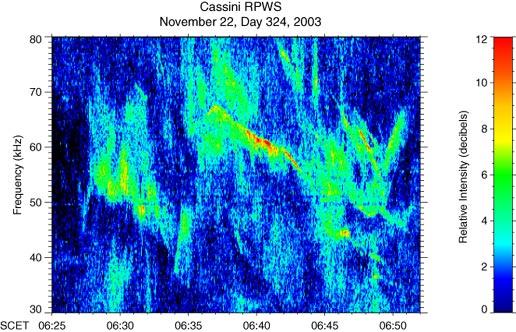
As observed by the now decommissioned Cassini spacecraft is majestic Saturn surrounded by its rings including a time-lapse sequence of Aurorae at Saturn’s North Pole (Saturn’s “Northern Lights”). Image credit: NASA/JPL and The California Institute of Technology (Caltech).
Saturn is a source of intense radio emissions and, starting in 2002, scientists at NASA have been monitoring that emission using instrumentation onboard the Cassini spacecraft. As a result, NASA was able to convert and translate the radio signals into sound in an effort to better understand the underlying phenomenon. This discovery is just one among many attributed to Cassini, one of the most successful NASA missions ever completed.
They have discovered that Saturn’s Eerie-Sounding Radio Emission is intimately related to the aurorae at the planet’s north and south poles, the same aurorae as Earth’s beautiful northern and southern lights.
+ Listen to the sound of Saturn’s radio emissions (wav download)
Link to video compilation of Saturn’s Aurora: https://www.jpl.nasa.gov/video/download.php?id=1277&download=cl
These radio emissions are intimately related to the aurorae at the north and south poles of the planet, the same aurorae as those observed from Earth as the beautiful Northern and Southern lights. This phenomenon observed at Saturn is the same in every aspect as that observed on Earth with the exception of size.

“Aurora as observed at Steinsvik, Troms, northern Norway. Image credit NASA/JPL and Tommy Richardsen.”
The radio emissions are produced when charged particles from the sun, known as the “Solar Wind”, impinge on Saturn’s powerful magnetic field, exceeded in strength only by Jupiter’s magnetic field.
The charged particles emit radio waves as they spiral along and follow the magnetic field lines to the north and south poles. Cassini’s two onboard instruments that were used for this discovery were the Magnetometer, an instrument that measures magnetic field strength and the Radio and Plasma Wave Science instrument, the instrument that originally detected the radio signals.
With Cassini’s radio and plasma wave science instrument, NASA scientists and engineers first detected these enigmatic radio emissions in April 2002 when the spacecraft was 374 million kilometers from Saturn.
Since their discovery, these enigmatic radio emissions remain an subject of active research and have provided the first high-resolution observations of this portion of the radio spectrum at Saturn. This complex spectrum, along with its rising and falling tones, reveals a remarkable array of variations in frequency and time and is very similar to Earth’s auroral radio emissions.
These aurorae strongly suggest the presence of numerous, small radio sources moving along the planet’s powerful magnetic field lines. In a manner consistent with the classic understanding of radio emission as discussed above, these small radio sources thread themselves in a beautifully complex web in and through the auroral regions.
These sounds, “The Sounds of Saturn”, give true meaning to the term “Other Worldly” and are not just eerie but also highly descriptive of the same phenomenon that gives rise to the Earth’s northern and southern lights.
Conclusion
By studying the underlying phenomenon occurring at a sister world in our own solar system and, by extension, anywhere else in the universe, we gain a deeper understanding and insight into our own world and our own existence.
After twelve years of unprecedented success, the Cassini Mission to Saturn and Titan has now ended in a spectacular manner with the spacecraft streaking through Saturn’s upper atmosphere between the planet’s cloud decks and its rings on 15 September of this year.
As the spacecraft streaked through Saturn’s sky like a meteor with all its cameras and instrumentation simultaneously active, it gathered as much data and as many images as possible, transmitting them back to earth in real time and at the speed of light. As the spacecraft concluded its “death spiral” at a velocity of 124,000 km/hr, it finally burned up in the giant planet’s atmosphere lest it crash-land on one of Saturn’s pristine moons and possibly contaminate it.
Those images and data are freely available, along with all the data and images obtained since the spacecraft began its mission of science and discovery at Saturn in 2005. For further information and to freely explore those data and images, please visit the mission home page at https://saturn.jpl.nasa.gov.

An artist’s illustration of Cassini diving between Saturn and the planet’s innermost ring. Credit: NASA/JPL-Caltech
 An artists illustration of the Cassini orbiter streaking through Saturn’s sky in its final moments, feverishly transmitting final data and images back to Earth. Credit: NASA/JPL-Caltech
An artists illustration of the Cassini orbiter streaking through Saturn’s sky in its final moments, feverishly transmitting final data and images back to Earth. Credit: NASA/JPL-Caltech



